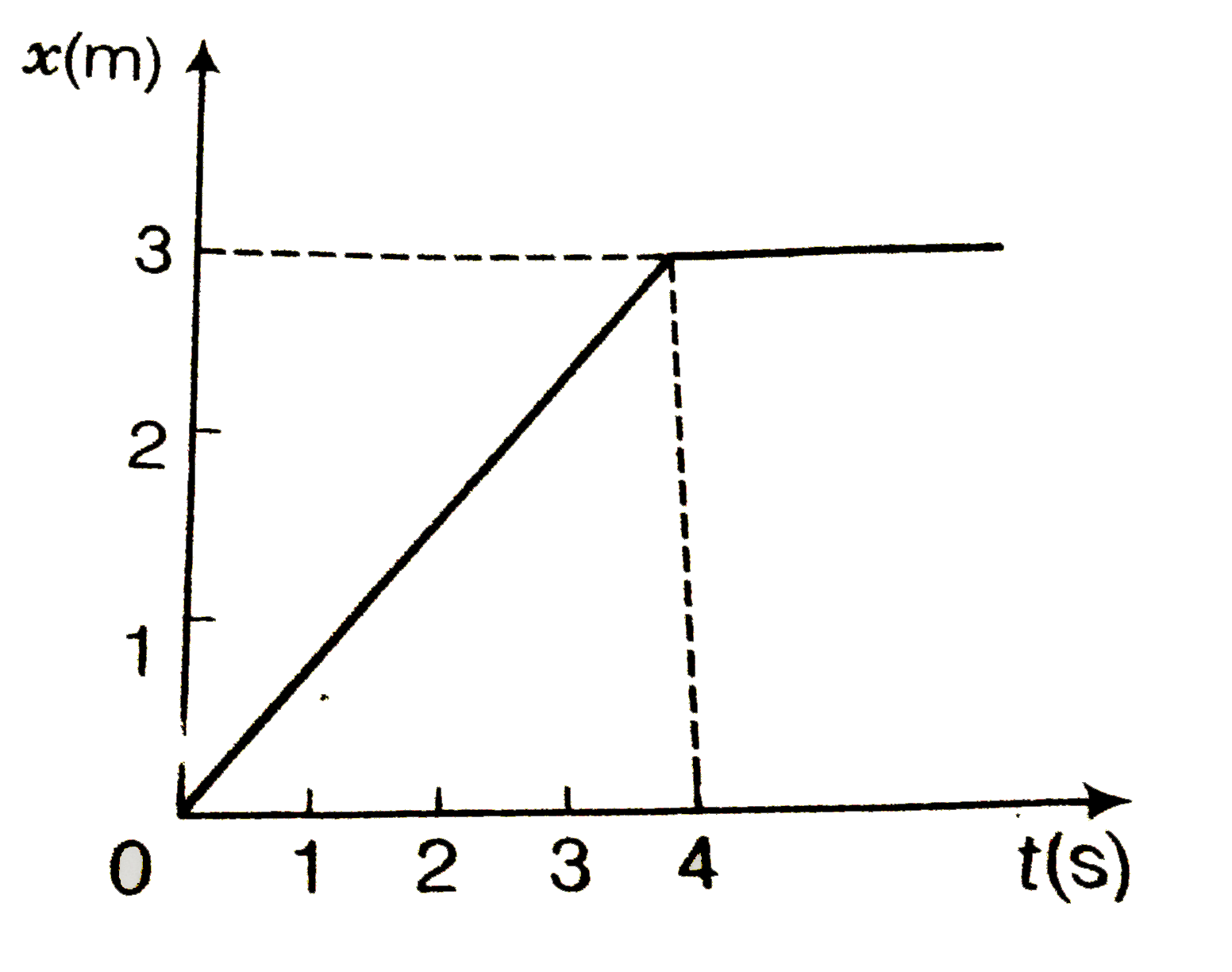Figure shows the position-time graph of a particle of mass 4 kg. What is the (a) force on the particle for t < 0, t > 4 s, 0 < t < 4 s? (b) impulse at t = 0 and t = 4 s ? (Consider one-dimensional motion only).
 Solution in Tamil
Solution in Tamil
(a) For t < 0. No force as Particles is at rest.
For > 4s, No force again particle comes at rest.
For 0 < t < 4s, as slope of OA is constant so velocity constant i.e., a = 0, so force must be zero .
(b) Impulse at t= 0
Impulse = change in momentum
I=m(v−u)=4(0−0.75)=3kgms−1
Impulse at t = 4s
I=m(v−u)=4(0−0.75)=−3kgms−1
Topper's Solved these Questions
- LAW OF MOTION BOOK - FULL MARKSCHAPTER - LAW OF MOTION EXERCISE - ADDITIONAL QUESTIONS SOLVED (SHORT ANSWER QUESTIONS (2 MARKS))
12 Videos
- KINETIC THEORY OF GASESBOOK - FULL MARKSCHAPTER - KINETIC THEORY OF GASESEXERCISE - Addtional Numerical Problems
10 Videos
- MOTION OF SYSTEM OF PARTICLES AND RIGID BODIESBOOK - FULL MARKSCHAPTER - MOTION OF SYSTEM OF PARTICLES AND RIGID BODIESEXERCISE - ADDITIONAL QUESTIONS SOLVED - III (LONG ANSWER QUESTIONS (5 MARKS))
6 Videos
Similar Questions
A man getting down a runnning bus falls forward
View SolutionIf the rms speed of hydrogen molecules at 300K is1930ms−1. Then what is the rms speed of oxygen molecules at 1200K.
View SolutionDerive an expression for center of mass for distributed point masses.
View SolutionShown the position time graph of a particle of mass 4 kg What is the force on the particle for t<0,0<t<4s motion only
 .
.
View SolutionShows position time graph of a particle of mass 100g Find the impulse at t=0 and at t=4s
 .
.
View SolutionFig. shows the position-time graph of a particle of mass 4 kg. What is the (i) force acting on the particle for t lt 0, t lt 4 s, 0 lt t lt 4 s ? (ii) impulse at t = 0 and t = 4 s? Assume that the motion is one dimensional.
View SolutionThe position-time graph of a body of mass 2 kg is as given in figure . What is the impulse on the body at t = 0 s and t = 4 s .
View SolutionFig. shows the position-time graph of a particle of mass 4 kg. What is the Force on the particle for t lt 0, t gt 4s, 0 lt t lt 4s? (b) Impulse at t= 0 and t= 4s ? (Consider one dimensional motion only)
View SolutionFigure shows the position-time graph of a particle of mass 4 kg. What is the (a) force on the particle for t 4 s, 0
View SolutionFigure shows the position-time graph of a particle of mass 4 kg. What is the (a) force on the particle for t 4 s, 0
View SolutionFigure shows the position-time graph of a particle of mass 4 kg. What is the (a) force on the particle for t < 0, t > 4 s, 0 < t < 4 s? (b) impulse at t = 0 and t = 4 s ? (Consider one-dimensional motion only).

View SolutionFig. shows the position-time graph of a particle of mass 4 kg. What is the (i) force acting on the particle for t lt 0, t lt 4 s, 0 lt t lt 4 s ? (ii) impulse at t = 0 and t = 4 s? Assume that the motion is one dimensional.
View SolutionFigure shows the position-time graph of a particle of mass 4 kg, then
a) force on the particle for t<0,t>4s,0<t<4s? ?
b) impulse at t = 0 and t = 4 s. (consider one-dimensional motion only)

View SolutionShows the position-time graph of a particle of mass 4 kg. What is the (a) force on the particle for t<0,t>4s,0<t<4 s ? (b) impulse at t = 0 and t = 4 s ? (Consider onedimensional motion only).

View SolutionThe position-time graph of a body of mass 2 kg is as given in figure . What is the impulse on the body at t = 0 s and t = 4 s .

View SolutionFigure shows the position - time graph of a particle of mass 4 kg, then
(a) force on the particle for r<0,t>4s,0<t<4s ?
(b) impulse at t = 0 and t = 4 s. (consider one - dimensional motion only)

View Solution
